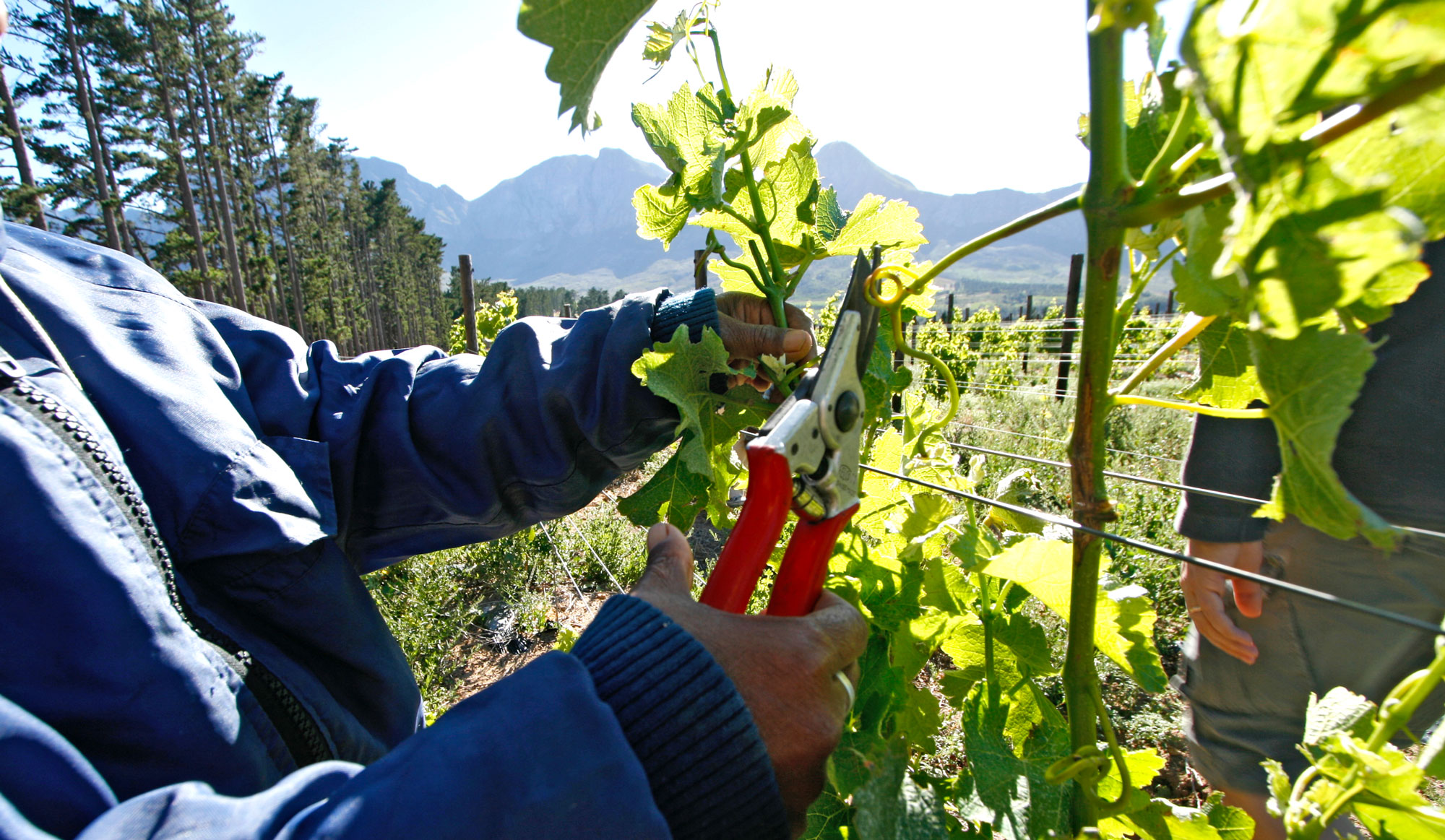
Vineyards & Winemaking
Skaap Wines vineyards are situated in the world renowned wine producing region of Stellenbosch, South Africa. A region that consistently produces some of the finest new-world wines.
Working in harmony with nature
Vineyards
We're situated in the world renowned wine producing region of Stellenbosch, South Africa. A region that consistently produces some of the finest new-world wines.
Our vineyards are located at the end of the Schapenberg (Afrikaans for sheep mountain) Wine Route, at an altitude of 230–275m. Nestled between the Hottentots-Holland Mountains and False Bay this area is known as the coolest in the Stellenbosch wine growing region.
When we bought the farm in 2006 it was overgrown with Pine and Blue Gum trees - both of which are considered invasive alien species. After learning how rare and endangered the local vegetation (fynbos) had become we decided to set aside a fifth of our land to establish a fynbos conservation corridor. This corridor connects two areas of pristine fynbos and acts as a migration corridor for endangered species.
View of the Shiraz vineyard from a section of the fynbos rehabilitation corridor
With the help of our farm manager who has extensive experience of farming on the Schapenberg we undertook extensive soil surveys to determine which varieties and root stocks would be best suited to the farm and how and where to plant them, taking into account the micro and macro climatic conditions.
The soils originate from 600 million year old decomposed granite with a high clay content which ensures good water retention. During the long, dry summer months enough water will slowly get sucked back up into the vineyards to ensure an effective leaf canopy and proper ripening of the fruit.
We decided upon 2 different varieties, Sauvignon Blanc and Shiraz, planted in 3 different blocks to take advantage of those specific aspects and soil types.
Skaap Vineyards
Block 3 – Shiraz
Altitude: 230-250 metres
Aspect: South Westerly
Coverage: 0.95 hectares
Soil type: Tukulu & Mispah
Route stock: Richter 110
Block 1 & 2 – Sauvignon Blanc
Altitude: 275 metres
Aspect: North Easterly
Coverage: 3.75 hectares
Soil type: Tukulu & Oakleaf
Route stocks: Ruggeri 140, Richter 99, Richter 110.
The altitude of the vineyard, cool sea air and strong South Easterly winds help keep temperatures lower in the hot summer months which helps to preserve the acidity and pH of the grapes, and reduces the fruit yield which results in an increased concentration of fruit flavours.
The trellis system was designed to take advantage of the wind, helping to keep the vineyard cooler, disease free and minimising (as much as possible) the fruit loss. The pruning and canopy management is performed by hand to create a smaller canopy which producesa higher quality and lower yield of fruit.
Block 3 – The Shiraz vines (230m-250m) overlooking False Bay
We use as many natural products as possible, to work in harmony with nature. We chose not to irrigate and each vine gets individual attention to ensure perfect balance and the production of small berries with concentrated fruit flavours.
Although not always the easiest, quickest or cheapest method of farming we're convinced a natural, sustainable approach to vineyard management produces the best wine and is kindest to the environment.
The vines are constantly monitored, with all pruning, spraying and harvesting being done by hand.
Winemaking
We have a no compromise attitude to getting the best possible wine in the bottle and it all begins with the grapes. It's impossible to make a great wine from poor grapes, which is why we take a long time selecting the best fruit. Once a picking date is agreed with the farm manager, 80% of the wine is already made. We monitor the ripening profile of the grapes and select on taste. We then know exactly which grapes are at their optimum ripeness and can harvest at precisely the right moment.
In the cellar, the focus is on allowing the grape to express it’s true character and that of its origin (“terroir”). For us, the role of the winemaker is to let the wine make itself. We only guide the wine in the right direction by selecting the correct yeast for it’s profile, giving more or less skin contact, fermenting at just the right temperature, or even ageing it in oak if it will improve the wine.
We keep ourselves up to date on the latest research and cellar technology to see if there’s anyway of improving the wine even further.




